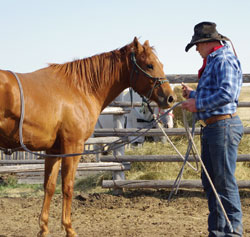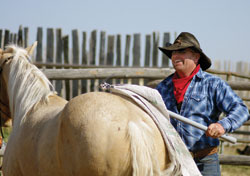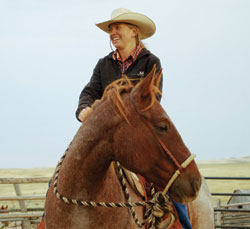Find the Problem and Fix It

Jack accepts the tarp dragging behind him. “Making safe, quiet horses is what I do,” says Joe Guy. The horse in the background is a seven-year-old gelding, unridden before the clinic.
 |
Joe Guy is able to do an uncanny imitation of the warning “blow” sound made by stallions, commanding a horses attention. Here, Joe used his “stallion blow” to make three-year-old Hoot stand still.
|
 |
Joe Guy using the flag to keep King’s mind focused. Since this one session, the horse hasn’t exhibited any of these tendencies, as described in the caption for photo 3.
|
 |
Joe Guy runs the stick over King, a five-year-old Quarter horse gelding who had an issue with locking up or bucking once in a while. Using the stick allows the horseman to “ask questions and look for issues.”
|
 |
|
Kirk, Joe Guy and a participant’s five-year-old Quarter horse gelding, Jack. The horse’s issue was being leery of anything behind him. Joe Guy is teaching Kirk how to apply and release pressure.
|
 |
Checking overhead pressure and looking for calmness in young Hoot’s reaction |
 |
Clinic participant Myla on her previously unridden four-year-old Quarter horse gelding, Snickers
|
For thousands of years, horses were ridden into battle boldly charging hordes of enemies, facing the blade of a sword to machine gun fire. Now it seems every horse is scared of a plastic bag. Why is that, do you suppose?
How the Horse Works
When you take a horse from the herd, the horse will automatically be asking questions of you like “Who are you?” and “What makes you think you are above me in the pecking order?” You see, that’s all a horse knows?—?fighting for and establishing dominance. He will ask you these questions in ways another horse would understand.
For example: turning away from you when you go to catch him; if you were a horse, this would be a threatening move. When you lead your horse and he crowds you, he is trying to show dominance. Laying an ear back as you cinch him is also a direct threat. If another horse ignores these questions or warnings, he will be chased, bitten or kicked. So as you are about to step into the saddle thinking your ride will be successful, ask yourself: “Did I ignore any or all of those questions that the horse asked me?” If he claims dominance he will not respect you?—?nor will he trust you.
Gaining Respect
My philosophy is simple common sense; I instantly rank the horse below me, no pain or harm should ever be shown. The relationship you need to build is one of trust and honesty, although you don’t want kindness to be mistaken for weakness?—?remember, you are the boss, he is the worker. Ask once, then demand. It’s as simple as chasing the horse off you every time it ignores your questions. Every command I teach my horse in the breaking process will be repeated on a daily basis.
The Psychology
The thing I love about a horse is they won’t lie to you. If they have an issue?—?whether it be to buck or bite, kick or fight?—?they will show you. Quite simply, I ask the horse where his issues lie and as I run a stick and flag over my horse the questioning begins. From the flag I then go to the tarp, adding more and more pressure from the ground up, and of course pressure from above, before I go to my rope and check the first, second and third cinch. By the time I have done all this the horse would have shown me everything I need to know, including how long it’s going to take me to be on his back. It’s generally half an hour to one hour from unbroken to riding. Seven days later I am often heading down the side of a highway or through town.
I have demonstrated this technique across Australia, the U.S. and Canada; I have yet to find a horse that can’t be helped. You don’t have to be a rocket scientist nor do you have to be a “whisperer.” You will need common sense, ability, and want to learn. Within minutes you can change your horse’s attitude; within an hour you can fix the problem your horse has been carrying and you have been dealing with for years.
Capture the Mind
Capture the mind and the horse will give you its body. If your horse kicks, do you go to fixing the back leg? If he bites, do you muzzle him? If he bucks, do you lunge him for an hour before you hop on? No. You cannot wear the body out to capture the mind because next time you bring him in you will have to repeat the whole process; tying that back leg to put a shoe on him, watching for those teeth as you cinch him, and praying when you hop on.
I will prove it all day long that once the dog knows not to leave the yard and the child knows not to help himself to the cookie jar, so too your horse will know you are the boss.
Joe Guy the Longrider is an Australian horseman who has ridden over 10,000 miles across three countries. Riding only “unbreakable” horses, Joe specializes in saving lives?—?of the horse and the rider. “I’m all about helping those that want to help themselves,” he says. For more on Joe Guy, click here. The photos were shot on the Mastad Ranch near McCord, Sask.
Photos by Jill Jenkins
